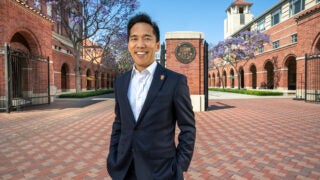
The Tajo Building (Courtesy of USC University Archives)
When the USC Gould School of Law Called Downtown L.A. Home
USC students of a century ago pursued law right in the middle of the legal scene: downtown Los Angeles’ hotbed of courthouses.
USC law students today tackle torts and ponder property law at the USC Gould School of Law on the south side of the University Park Campus. But here’s a little USC law school history: 100 years ago, the school’s students went to class nearly five miles away, in downtown Los Angeles.
From 1911 to 1925, USC’s law school was in the Tajo Building at the northwest corner of North Broadway and West First Street. Today, the First Street U.S. Courthouse still stands across the street from the site.
The Tajo Building was erected at the behest of Simona M. Martinez Bradbury, widow of millionaire Lewis Bradbury. Architects George Herbert Wyman and William Lee Woollett designed the structure. Fans of the L.A. architecture scene would recognize Wyman as one of the creators of the landmark Bradbury Building and its famous Victorian atrium.
Students Who Made USC Law School History
USC’s law school settled into the building at a time when the United States had just seen record numbers of immigrants. Enrollment at the law school reflected the arrival of these new Americans. A 1912 school yearbook shows Japanese, Filipino, Armenian and Russian Jewish students. Reflecting the diversity of the city, the school’s second black student also appears in the book, as do women. Students founded Phi Delta Delta, the nation’s first law student sorority, during this era.
Only a few years later, Mabel Walker Willebrandt LLB ’16, LLM ’17 graduated. She would become one of the nation’s most prominent female attorneys from the 1920s through the 1940s. Under President Warren G. Harding, Willebrandt served as assistant attorney general.
Mirroring the changing faces of Los Angeles, the school also counted You Chung Hong LLB ’24, LLM ’25 as an alumnus. Hong’s father was a Chinese immigrant who had worked on the railroads. After leaving USC, Hong became the first Chinese American admitted upon examination to practice law in California. He specialized in immigration law and became a leading civil rights attorney over the next four decades.
By 1925, USC leaders built a permanent law school on the University Park Campus and students moved south. Thirteen years later, the Tajo Building was demolished. But the area still hosts its share of legal scholars: The L.A. Law Library now stands where so many aspiring Trojan attorneys once studied.



